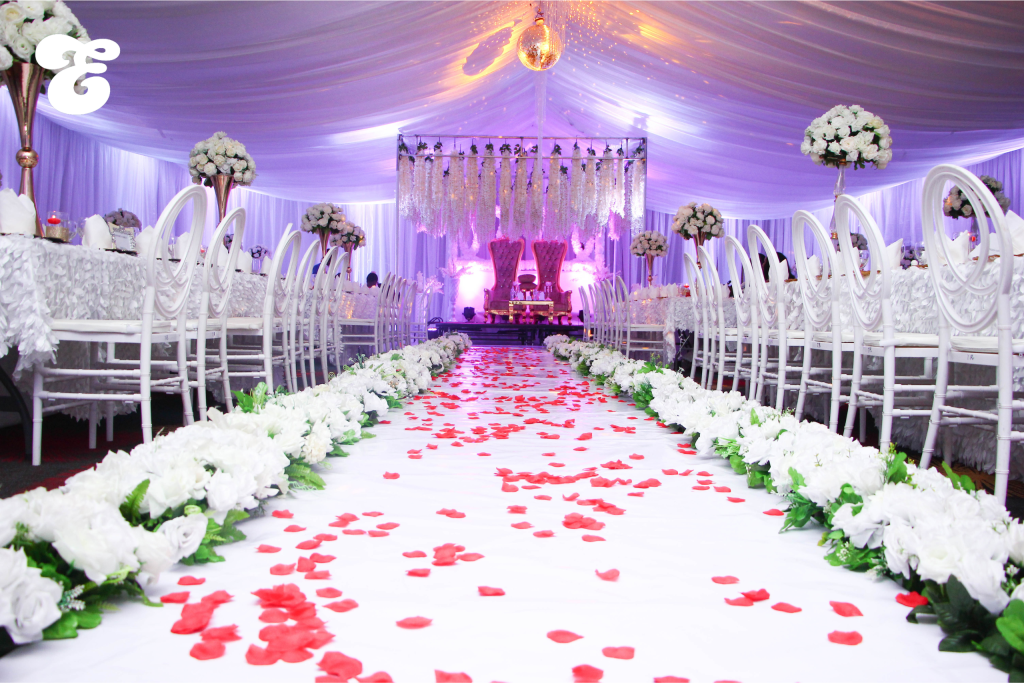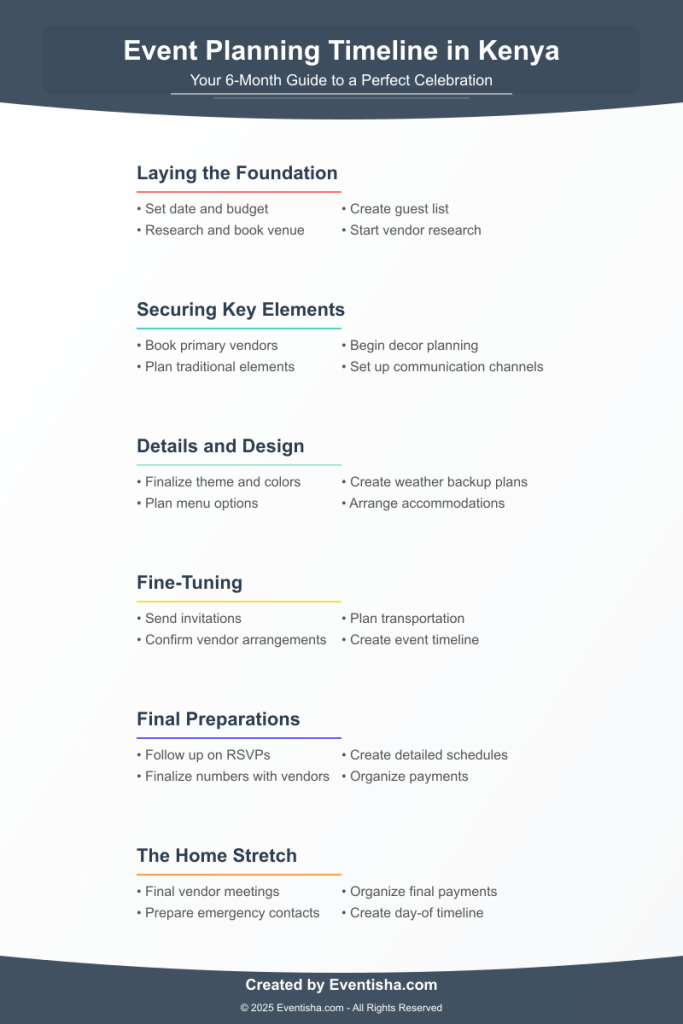The Ultimate Timeline: What to Do 6 Months Before Your Event in Kenya


Event planning in Kenya requires careful consideration of both modern and traditional elements, local weather patterns, and unique cultural aspects that make celebrations in this vibrant country truly special. Whether you’re organizing a wedding, milestone birthday, or family reunion, starting your planning journey six months ahead ensures a smooth and memorable celebration. This comprehensive guide will walk you through each crucial step of the planning process, helping you create an unforgettable event that reflects both your vision and Kenya’s rich cultural heritage.
Month 6: Laying the Foundation
The first month of your planning journey sets the tone for everything that follows. Begin by having an honest conversation with all stakeholders about the budget. Kenyan events often involve extended family and community members, so establishing clear financial boundaries early is crucial. When setting your date, consider Kenya’s weather patterns – the long dry season from December to March and the shorter one from July to October are particularly popular for outdoor celebrations.
Venue selection in Kenya offers an exciting array of options, from luxurious hotels in Nairobi and Mombasa to stunning outdoor locations in places like Naivasha or the Maasai Mara. Start by visiting potential venues during the same time of day as your planned event to assess natural lighting and weather conditions. Many premium venues in Kenya book up to a year in advance, especially during peak season, so securing your location should be a top priority.
Creating your guest list goes hand in hand with venue selection. Kenyan celebrations often tend to be larger than anticipated, so build in a buffer of 10-15% above your venue’s capacity when creating your initial list. This is also the time to start researching vendors, particularly those who book up quickly such as popular photographers and entertainment groups. Keep a spreadsheet of potential vendors, their packages, and contact information for easy reference.
Month 5: Securing Key Elements
With your foundation in place, month five is about locking in the essential vendors who will bring your vision to life. Start with your catering team – Kenyan events are known for their generous hospitality, and food plays a central role in any celebration. Schedule tastings with potential caterers and discuss how to blend traditional Kenyan dishes with modern cuisine if desired. Consider dietary restrictions and how to accommodate them while maintaining the integrity of your menu.
Entertainment booking should be a priority during this month. Whether you’re considering a live band, DJ, traditional dancers, or a combination, popular entertainers in Kenya often have packed schedules. When meeting with entertainment vendors, discuss their experience with your type of event and venue, their backup equipment plans, and their familiarity with both traditional and contemporary music that will appeal to your guest list.
This is also the perfect time to explore ways to incorporate traditional Kenyan elements into your celebration. Consider working with local artisans for decorative elements, hiring traditional performers for a segment of your entertainment, or incorporating meaningful cultural ceremonies into your event schedule. Event communications should also begin taking shape – consider creating a WhatsApp group for key participants and starting a digital planning folder to keep everyone informed and aligned.
Month 4: Details and Design
As you enter the fourth month before your event, it’s time to focus on the aesthetic elements that will make your celebration unique. Kenya’s rich artistic heritage offers countless inspiration sources for your event’s design. Work with your vendors to create a cohesive theme that reflects both your personal style and the local environment. Consider incorporating traditional Kenyan textiles like kanga or kitenge into your decor scheme, or using local flowers and materials to create stunning centerpieces.
Weather contingency planning becomes crucial during this phase. While Kenya’s climate is generally favorable, having a solid backup plan is essential. If you’re planning an outdoor event, discuss tent options with your venue or rental company. Consider factors like shade structures, fans or cooling systems for daytime events, and adequate lighting for evening celebrations. This is also the time to think about guest comfort – arrange for sufficient seating areas, water stations, and possibly climate control depending on your venue and time of year.
For guests traveling from other parts of Kenya or internationally, now is the time to organize accommodation arrangements. Research hotels and lodges at different price points near your venue and consider negotiating group rates. Create a comprehensive list of accommodation options to share with your guests, including details about transportation and local attractions they might want to visit while in the area.
Month 3: Fine-Tuning
With three months remaining, your focus shifts to refining the details and ensuring all elements work together seamlessly. This is the ideal time to send out your invitations, whether through traditional paper mailings, digital means, or both. In Kenya, it’s common to follow up formal invitations with personal calls or messages, so build this time into your schedule. Create a system for tracking RSVPs and dietary requirements, and begin thinking about seating arrangements if applicable.
Transportation logistics require careful consideration in Kenya. Evaluate the need for shuttle services between accommodations and your venue, especially if you’re hosting in a location like Naivasha or other areas outside major cities. Consider hiring professional drivers familiar with local roads and conditions, and build in buffer time for typical traffic patterns, particularly in urban areas like Nairobi.
Vendor coordination becomes increasingly important during this phase. Schedule individual meetings with each key vendor to review their requirements, timeline, and specific roles during the event. Create a master timeline that includes setup times, delivery schedules, and key moments during your celebration. Share this timeline with all vendors and key participants to ensure everyone is aligned with the schedule.
Month 2: Final Preparations
As you enter the second-to-last month, your focus shifts to confirming and fine-tuning all arrangements. Follow up with guests who haven’t responded to your invitation, as final numbers will affect various aspects of your event, from catering to seating arrangements. In Kenya, it’s not uncommon for guests to confirm late, so maintain some flexibility in your numbers while gently encouraging timely responses.
This is the time to create detailed schedules for everyone involved in your event. Work with your vendors to develop a comprehensive timeline that includes setup, delivery times, and key moments during the celebration. Consider local traffic patterns and potential delays when creating these schedules. Meet with your venue coordinator to review all logistics, including power requirements for entertainment, loading areas for vendors, and parking arrangements for guests.
Payment schedules should be organized during this month. In Kenya, many vendors require a significant portion of payment before the event, so ensure your payment timeline aligns with vendor requirements and your own cash flow. Create a detailed budget tracker that includes all outstanding payments, due dates, and payment methods. Keep copies of all contracts and payment receipts in an easily accessible location.
Month 1: The Home Stretch
The final month before your event is about confirming every detail and preparing for any last-minute adjustments. Schedule final meetings with all your vendors to review their responsibilities and timelines. Create an emergency contact list that includes backup numbers for all key vendors and share it with your support team. In Kenya, it’s wise to have local contacts who can help resolve any last-minute issues that might arise.
Prepare final payments for vendors and organize them in clearly labeled envelopes or set up mobile money transfers in advance. Review your event timeline one last time with all participants and create multiple copies to distribute to key team members. Consider creating a day-of emergency kit that includes items like safety pins, tape, phone chargers, and any essential supplies specific to your event type.
If you’re incorporating any traditional elements or ceremonies, schedule a final review with the cultural advisors or elders involved to ensure all necessary preparations are complete. Make sure any special items required for traditional aspects of your celebration are prepared and safely stored. Finally, delegate specific responsibilities to trusted friends or family members for the day of the event, ensuring you can focus on enjoying the celebration you’ve so carefully planned.
Remember, while this timeline provides a structured approach to event planning in Kenya, flexibility remains key. Understanding and embracing local customs, working with experienced vendors, and maintaining open communication with all participants will help ensure your event is a memorable success.
Conclusion: Bringing It All Together
The six-month journey to creating your perfect event in Kenya is a blend of careful planning, cultural awareness, and adaptable execution. While this timeline serves as your roadmap, it’s important to understand that every event is unique and may require adjustments based on specific circumstances. The key to success lies in starting early and maintaining organized documentation of all your planning efforts.
One of the most beautiful aspects of hosting an event in Kenya is the opportunity to blend modern celebrations with rich cultural traditions. Whether you’re planning a wedding that honors both contemporary and traditional customs, or organizing a milestone celebration that brings together multiple generations, Kenya’s diverse heritage offers countless ways to make your event truly special.
Keep in mind that successful events in Kenya often rely heavily on personal relationships and community involvement. Take time to build good rapport with your vendors, venue staff, and local contacts. These relationships can prove invaluable when you need last-minute assistance or local insights. Additionally, embrace the warm, communal spirit that characterizes Kenyan celebrations – it’s this unique atmosphere that will make your event memorable for all who attend.
Finally, remember that while planning is essential, the ultimate goal is to create joyful memories. In the days leading up to your event, take moments to step back and appreciate the journey. Trust in the preparations you’ve made, rely on the team you’ve assembled, and most importantly, be present to enjoy the celebration you’ve so carefully crafted. With proper planning and the right mindset, your event in Kenya will be an unforgettable experience that lives up to all your expectations and beyond.
